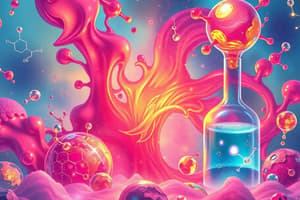Podcast
Questions and Answers
Which ion is formed when hydrogen ions combine with water molecules?
Which ion is formed when hydrogen ions combine with water molecules?
- Chloride ion (Cl-)
- Oxide ion (O2-)
- Hydroxide ion (OH-)
- Hydronium ion (H3O+) (correct)
What type of acids do not dissociate completely in water and produce weak conjugate bases?
What type of acids do not dissociate completely in water and produce weak conjugate bases?
- Moderate acids
- Neutral acids
- Strong acids
- Weak acids (correct)
Which type of compounds turn red litmus paper blue when dissolved in water?
Which type of compounds turn red litmus paper blue when dissolved in water?
- Nitric acid
- Strong bases (correct)
- Hydrochloric acid
- Sulfuric acid
What is the characteristic taste of acids in an aqueous medium?
What is the characteristic taste of acids in an aqueous medium?
Which of the following bases do not dissociate completely in water?
Which of the following bases do not dissociate completely in water?
What ions do strong bases like sodium hydroxide dissociate into when dissolved in water?
What ions do strong bases like sodium hydroxide dissociate into when dissolved in water?
Which type of substances conduct electricity due to the presence of hydrogen ions?
Which type of substances conduct electricity due to the presence of hydrogen ions?
What color does litmus paper turn when it comes in contact with an acid?
What color does litmus paper turn when it comes in contact with an acid?
An acid-base reaction results in the production of which of the following?
An acid-base reaction results in the production of which of the following?
Which of the following substances has a sour taste?
Which of the following substances has a sour taste?
What is the pH range of bases on the pH scale?
What is the pH range of bases on the pH scale?
Which of the following is an example of a weak base?
Which of the following is an example of a weak base?
Study Notes
Chemistry: Acids, Bases, and their Properties
Acids
Acids, a type of compound characterized by their sour taste in aqueous medium and their ability to turn blue litmus paper red, are a fundamental concept in chemistry. They are substances that release hydrogen ions (H+) when dissolved in water. Hydrogen ions form the hydronium ion (H3O+) when they combine with water molecules. There are two types of acids: strong and weak.
Strong Acids
Strong acids, such as hydrochloric acid (HCl), dissociate completely into hydrogen and chloride ions when dissolved in water, thereby releasing H+ ions into solution. Examples of strong acids include sulfuric acid (H2SO4) and nitric acid (HNO3).
Weak Acids
Weak acids, like acetic acid (CH3COOH), do not dissociate completely in water and produce weak conjugate bases. Examples of weak acids include citric acid and formic acid.
Bases
Bases are substances that turn red litmus paper blue when dissolved in water. They release hydroxide ions (OH-) when dissolved in water. Like acids, there are two types of bases: strong and weak.
Strong Bases
Strong bases, such as sodium hydroxide (NaOH) and potassium hydroxide (KOH), dissociate almost entirely into hydroxide and cation ions when dissolved in water, thereby releasing OH- ions into solution.
Weak Bases
Weak bases, such as ammonia (NH3) and carbonates, do not dissociate completely in water and produce weak conjugate bases. Examples of weak bases include sodium carbonate (Na2CO3) and magnesium hydroxide (Mg(OH)2).
Properties of Acids and Bases
Acids and bases have several physical and chemical properties. Among these, the most notable are:
- Taste: Acids have a sour taste, while bases are bitter and alkaline.
- Solubility: Acids are generally soluble in water, while bases can be soluble or insoluble in water.
- Conductivity: When dissolved in water, acids conduct electricity due to the presence of hydrogen ions, while bases conduct electricity due to the presence of hydroxide ions.
- Indicators: Certain substances, such as litmus paper, can be used to identify acids and bases based on their color change. Acids turn blue litmus paper red, while bases turn red litmus paper blue.
- pH Scale: Acids have a pH value less than 7, while bases have a pH value greater than 7. The pH scale is a measure of the concentration of H+ and OH- ions in a solution.
Acid-Base Reactions
Acids and bases can react with each other to form salts and water. This is known as an acid-base reaction or a neutralization reaction. When an acid reacts with a base, the H+ ions from the acid react with the OH- ions from the base, producing H2O and a salt. For example, hydrochloric acid (HCl) reacts with sodium hydroxide (NaOH) to produce sodium chloride (NaCl) and water (H2O).
In conclusion, acids and bases are essential concepts in chemistry, with properties including sour taste, hydrogen ion production, and the ability to react with each other to form salts. They are characterized by their physical and chemical properties, such as solubility, conductivity, and indicators, and are classified as strong or weak based on their degree of ionization. Understanding the properties of acids and bases is crucial for understanding various chemical reactions and processes.
Studying That Suits You
Use AI to generate personalized quizzes and flashcards to suit your learning preferences.
Description
Test your knowledge on acids, bases, their properties, and acid-base reactions in chemistry. Learn about the characteristics of acids and bases, including taste, solubility, conductivity, indicators, and the pH scale. Explore the types of acids and bases, such as strong and weak, and how they interact in neutralization reactions to form salts and water.




